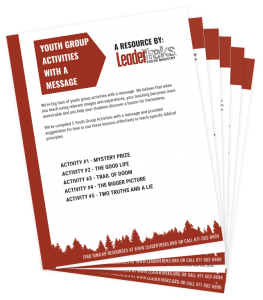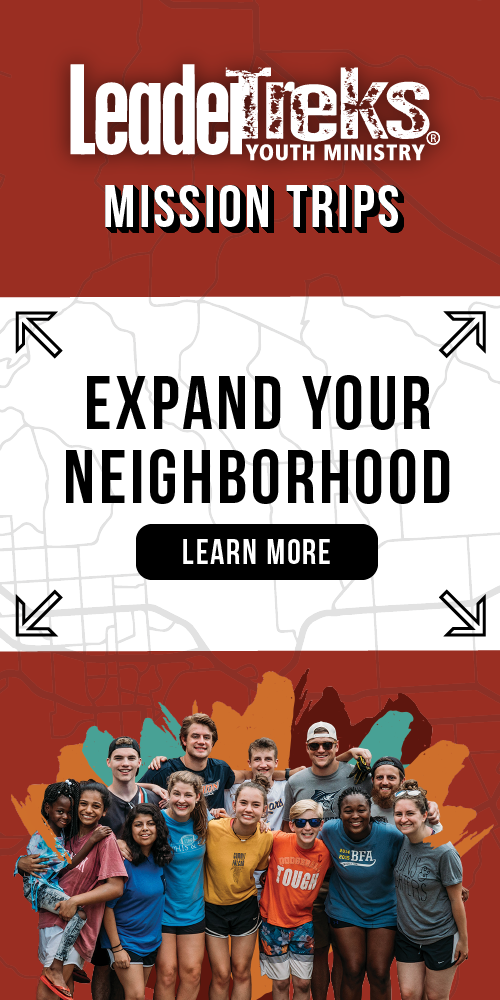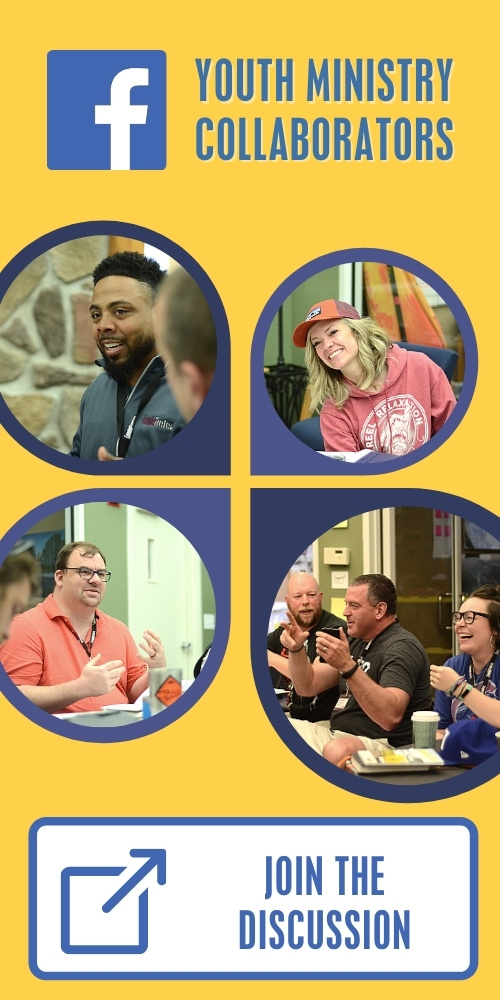Youth Group Activities with a Message
5 Great Activities that Teach a Clear Message
We’re big fans of youth group activities with a message. We believe that when you teach using relevant images and experiences, your teaching becomes more memorable and you help your students discover a lesson for themselves.
We’ve compiled 5 Youth Group Activities with a message and provided suggestions for how to use these lessons effectively to teach specific biblical principles.
Click here to download a PDF of this article.
Youth Group Activity #1: Mystery Prize
Main Message: Dealing with Temptation
This lesson comes from the Identity Root in The Core One-Year Bible Study Curriculum.
Use this activity to help students discover that Jesus willingly lived a life full of temptation so that we could learn to resist our own temptations.
What you’ll need:
- A large empty box
- An empty envelope
- Toilet Paper
- Stickers
- An actual prize (i.e. cookies, donuts, soft drinks-enough for each student)
Instructions:
Beforehand, place the toilet paper in the box. Place the stickers in the envelope. Position the box and envelope in front where the students can see them. Hide the actual rewards in another room or somewhere the students won’t notice.
Say something like: Tonight you all get a prize, and I will too! But it’s up to you to decide which prize you end up with and which one I take home. Up here you see a box and an envelope. Each contains some prize that the whole group will share. One prize is definitely better than the other. But you can only choose one. The best part: I get the prize that you don’t choose. As a group, take the next five minutes to debate about which package you want to open. You have to come up with a unified decision, or I get to keep both prizes. Or if you want some help, ask me, and I’ll choose for you!
Give the students five minutes to debate amongst themselves. When they’ve reached a decision, do one of the following:
Scenario A:
If they decide to open the box or envelope, let them open it. Then open the other, to show that they both contained mediocre prizes. Tell them that if they’d let you choose for them, you would have given them a better, third prize.
Ask the following questions:
- Think about your decision-making process. Why did you choose the option you did?
- Did anyone want to go with the other option? How were you persuaded to join the others in favor of the option you chose?
- How were these convincing voices like the voices of temptation we hear every day (for example: Satan, other people, or your own thoughts)?
- Why didn’t you trust me to pick the best prize for you?
Once they’ve discussed these questions, tell the students that you’ve decided to let them have the third prize anyways. Reveal the actual prizes and distribute them to students.
Scenario B:
Ask the following questions:
- Think about your decision-making process. Why did you decide to let me choose?
- Did anyone want to go with the box or envelope? What was said that convinced you to ignore the temptation to choose your own path and rely on me?
- How was relying on me to make the decision similar to relying on Christ to avoid temptation?
Teach:
It’s hard to rely on other people. We expect them to act in their own interest. But Jesus willingly lived a life full of temptation and pain so that we could learn to resist our own temptation. And if he’s the Lord of our lives, he chooses the best reward for us even though we regularly give in to temptation.
Youth Group Activity #2: The “Good Life”
Main Message: Following God’s Instructions
This lesson comes from the Prodigal Disciple Now Retreat Curriculum.
Use this youth group activity to teach students the importance of following God’s instructions rather than chasing after the ways of the world.
What you’ll need:
- Large pieces of paper or cardboard (enough for each student to have a piece or one big piece for the group to work on together)
- Old magazines (make sure they are relatively current and have a lot of ads/pictures in them)
- Scissors
- Glue or tape
Instructions:
Say Something Like: Everywhere we look, we are bombarded with messages of what “the good life” looks like. The goal is to convince us to go after the things the world says will give us freedom, at any cost, so, we’re going to look at exactly what kinds of messages we’re receiving. You’ll have ten minutes to go through these magazines and find examples of images that advertisers are using to sell a version of “the good life.” Cut out and paste them onto your piece of cardboard. Try to find at least three or four of them. Then we’ll come back together and share what we found.
Discuss:
- Where in the magazine did you find most of these images?
- What do you think was the intent of these images? What type of life were they trying to sell?
- Did these images make you want to pursue this kind of life?
- What influences your choices about how you live your life today?
Teach:
Everywhere we look, commercials, internet ads, and culture try to convince us that “the good life” means parties, popularity, money…and they encourage us to go after those things at any cost. We convince ourselves that this is what “the good life” looks like; we get so caught up chasing it that nothing else matters. But chasing “the good life” often leads us to places we never thought we’d go, doing things we never thought we’d do. A lot of times we see God’s rules (as laid out in the Bible) as a way to control us and keep us from doing the things we really want (sin), but the truth is that God knows what is good for us better than we do. His ways are higher than our ways, and his instructions are for our good.
Youth Group Activity #3: Trail of Doom
Main Message: The Cost of Discipleship
This lesson comes from the Walking with Jesus series in The Black Letters of Jesus One-Year Bible Study Curriculum.
Use this activity to teach students that disciples of Christ follow Jesus no matter it costs.
What you’ll need:
- A large sheet of paper and a marker for each group of students
Instructions:
Say something like: Congratulations! You’re about to go on a multi-day hike through one of the National Parks. Unfortunately, the only trail within driving distance is called the Trail of Doom. It’s full of challenges and dangers, so you’ll want to prepare well before we set out. Each team gets one backpack with room for only seven items inside. These items can be as big or as small as necessary, but each item can only be used once on the trail.
- Split students into groups of no more than five. You’ll want several groups, so if you only have a few students, they can do this individually, too.
- Pass out a large sheet of paper and a marker to each group. Ask each team to choose seven items to pack in their group backpack and then write (or draw) them on the paper.
- Once teams are done, “take” them on their hiking journey by describing the trail and a series of challenges that appear each day they’re hiking on the Trail of Doom.
- Each time the groups encounter a challenge, they should choose one item from their packs to overcome the challenge. If they packed something appropriate, they survive until the next day. If a group didn’t pack anything to overcome the challenge, the group doesn’t make it. If the item a group chooses to overcome a challenge is questionable, have them defend their choice.
- You, as the Park Ranger, have complete say over whether or not a group survives.
- The team to survive the longest or the team(s) to make it through all seven days wins.
As you come up with challenges, start with common challenges hikers might expect to encounter on a trail. The further teams make it on the trail, the crazier the challenges should become. Below you’ll find an example of what the days might look like, but feel free to change them up and get creative.
Example Challenges:
Day 1: Unexpected Blizzard (items to survive might include matches, a blanket, a coat)
Day 2: Whitewater River Crossing (items to survive might include a life jacket, an inflatable raft, or even a hang glider)
Day 3: Grizzly Bear Attack (items to survive might include bear spray, a steak to lure the bear away, a baseball bat to fight the bear—though the Park Ranger might have to decide whether or not that would work)
Day 4: An Avalanche
Day 5: A Lake of Hot Lava
Day 6: A Pack of Mountain Lions
Day 7: A Tourist Invasion
Discuss:
- Were you surprised by any of the challenges you encountered on the Trail of Doom?
- What made some challenges easier to prepare for than others?
- What are a few ways you might learn what challenges to prepare for on the journey of discipleship?
- How might walking the discipleship journey with other people help in times of difficulty?
Teach:
Jesus knows the journey of discipleship isn’t easy. The same crowds that followed him one minute were quick to turn on him when he said something they didn’t like (John 8:59). Jesus wants as many people as possible to repent and follow him (2 Pet. 3:9), but he doesn’t want a bunch of people tagging along who are unwilling to sacrifice the things they love more than him: money, prestige, and even amiable relationships with friends and family. Write down one thing you can do this week in order to look ahead and prepare for a challenge you might encounter on your walk with Jesus.
Youth Group Activity #4: The Bigger Picture
Main Message: Eternal Perspective
This lesson comes from the Renew Disciple Now Retreat Curriculum.
Use this youth group activity to help students see that following Jesus causes a shift in our priorities.
What you’ll need:
- A camera or camera phone
- A printer or screen to show pictures
Instructions:
- Before the activity, walk around the room or building in which you’re holding the small group. Using a camera or camera phone, take extreme close-up shots of 10 or so items: book pages, a pen, a number on a clock, or anything else you can find. Try to have fun with it by choosing a few odd items, like a koosh ball, a toy dinosaur, or something else less familiar. Keep these pictures as focused as possible. If you’re using a smart phone, you’ll have better luck keeping things in focus by zooming in rather than moving the lens super close to the object. Try to capture the texture of the item, but make sure it’s not easily identifiable. Then take a picture of each item from a distance, so it’s recognizable.
- Either print out the extreme close-up pictures for each student, or display them on a screen one-by-one for everyone to see. Have students guess what each item is based only on the extreme close-up.
- Finally, go back through the 10 close-ups, each followed by the zoomed-out picture that reveals what the object actually is. Have students tally how many of the objects they guessed correctly.
Discuss:
- Which object was hardest to identify from the extreme close-up? What made it difficult?
- Think about your top priorities in life right now. What are they? What are the things you work the hardest for? What are the things you’re always thinking about?
- Now, based on those priorities, think about your perspective on life right now. Are you looking at life like an extreme close-up, only focusing on the here and now and not thinking about the future? If not, how “zoomed-out” are you (mid-range, wide-angle, or bird’s eye view)? How might your close-up view of life come back to bite you in the future?
Teach:
If we’re only focused on the short-term and the things that won’t last, then we’re just as confused as someone looking at one of those zoomed-in pictures. The good news is, when we start following Jesus as the lord of our lives, He renews our soul by making us aware of the bigger picture. As we zoom out, concentrating less on right now and our immediate context, then our priorities will start to shift. When your soul has an eternal perspective, you’ll focus less on yourself and more on other people (even people halfway around the world), you’ll stop doing things that feel good now but cause major problems in the long term, and you’ll start trading in temporary treasures for eternal blessings.
Youth Group Activity #5: Two Truths and a Lie
Main Message: Two-Faced Christianity
This lesson comes from the Intersections One-Year Bible Study Curriculum.
Use this activity to challenge students to reconsider the hypocrisy of two-faced Christianity.
What you’ll need:
- Pens and 3×5 cards for each participant
Instructions:
In this classic game, students will test their knowledge of each other as well as their ability to discern when one of their friends is stretching the truth. As you debrief the activity, you and your students will take a deeper look at how the lies of hypocrisy and judgment affect our lives together in God’s family.
- Have your students sit in a circle no larger than ten students. If you have a group larger than ten, consider splitting into smaller circles that can be facilitated by another adult.
- Pass out a pen or pencil and a 3”x5” card to every student.
- Instruct each student to write two things about themselves that are true and one thing that is a lie on their card.
- Say something like: As you think of which two truths and one lie to write on your card, try to make them hard for us to discern which is which! For example, if you write down that you have been to the moon, I’ll probably be able to tell that you’re lying. The hardest lies to detect are one’s that are closest to the truth.
- Ask each student to read their two truths and a lie in a random order.
- Have the rest of the students vote for which statement they believe to be a lie.
- Once the lie is guessed by the group or revealed by the student, have the next student in the circle read his or her two truths and a lie.
- Continue until each student has read from his or her card.
Discuss:
- Which was easier to come up with: the truths or the lie? Why?
- How are hypocrisy and judgment like lies that we may tell or believe?
- How have you seen the lies of judgment and/or hypocrisy disrupt relationships?
- Are there any current divisions caused by judgment and or hypocrisy that you need to ask Jesus to heal?
Teach:
The word “hypocrite” comes from a Greek word meaning “actor” or “pretender.” That’s enlightening, isn’t it? These days, it means a person who acts one way with one group of people and another way with others. Here’s another word for the hypocritical you may have heard: two-faced. Sometimes we’re guilty of pretending to be someone you’re not or saying things we don’t mean. Disciples of Christ refrain from judgment and hypocrisy.
Click here to download a PDF of this article.
About the Author
Angie Franklin
Angie Franklin is the Director of Operations at LeaderTreks and has worked in youth ministry since 2000. She loves serving youth workers who are in the trenches by providing them with practical resources. She is a graduate of Moody Bible Institute and now lives in West Chicago, Illinois with her husband, Doug, and their dog,… Read More






